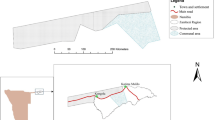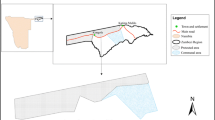Abstract
Land cover change in protected areas is often associated with human use, especially illicit extraction, but the direction and spatial distribution of such effects and their drivers are poorly understood. We analyze and explain the spatial distribution of vegetation change at the Kumbhalgarh Wildlife Sanctuary in the Aravalli range of Rajasthan, India using remotely sensed data and observation of conservation institutions. Two satellite images are examined in time series over the 13 years following the founding of the sanctuary through a cross-tabulation technique of dominant classes of vegetation density. The resulting change trajectories are compared for their relative distance to high-traffic forest entrance points for local users. The results show 28% of the study area undergoing change, though in multiple trajectories, with both increasing and decreasing density of vegetation in discrete patches. Areas of change are shown to be closer to entrance points than areas experiencing no change. The patchiness of change results from complex issues in local enforcement authority for middle and lower-level officials in Forest Department bureaucracy, leading to further questions about the efficacy and impact of use restrictions in Protected Areas.









Similar content being viewed by others
References
Agrawal A (2005) Environmentality: technologies of government and the making of subjects. Duke University Press, Durham, North Carolina
Ball GH, Hall DJ (1965) Isodata: a novel method of data analysis and pattern classification. Stanford Research Institute, Menlo Park, California
Bhuiyan C (2004) Various drought indices for monitoring drought condition in Aravalli terrain of India. Paper read at XXth ISPRS Congress, 12–23 July, at Istanbul, Turkey. Available online at: http://www.isprs.org/istanbul2004/comm7/papers/243.pdf
Brower B, Dennis A (1998) Grazing the forest, shaping the landscape? Continuing the debate about forest dynamics in Sagarmantha National Park. In Zimmerer KS, Young KR (eds.) Nature’s geography: new lessons for conservation in developing countries. University of Wisconsin Press, Madison, Wisconsin pp 184–208
Cardillo M, Mace GM, Gittleman JL, Purvis A (2006) Latent extinction risk and the future battlegrounds of mammal conservation. Proc Natl Acad Sci 103:4157–4161
Ceballos G, Ehrlich PR (2002) Mammal population losses and the extinction crisis. Science 296:904–907
Chhangani AK (2000) Ecobehavioural diversity of langurs (Presbytes entellus) living in different ecosystems (Unpublished Ph.D. Thesis). Jodhpur, India: Jai Narain Vyas University
Chhangani AK (2004) Present status of wild taxa of Kumbhalgarh Wildlife Sanctuary in the Aravalli Hills and its conservation and management. In Verma SR (ed) Protected habitats and biodiversity. Nature Conservators Publications pp 161–180
Chhangani AK, Mohnot SM, Pandey RP (2002) Consumption of different plant parts by wild Hanuman langurs and their known medicinal practice by local people in Aravallis of Rajasthan, India. J Econ Taxon Botany 26:419–439
Chief Wildlife Warden Kumbhalgarh Wildlife Sanctuary (1996) Management plan: Kumbhalgarh Wildlife Sanctuary 1996–1997 to 2000–2001. Udaipur: Rajasthan Forest Service
Corbridge S, Williams G, Srivastava M, Veron R (2005) Seeing the State: governance and governmentality in India. Cambridge: Cambridge University Press
Eastman R, Mckendry J, Fulk M (1991) Change and time series analysis. Geneva: UNITAR
ERDAS (1991) ERDAS field guide (fourth ed, revised and expanded). Atlanta: ERDAS, Inc
Foucault M (1980) Two lectures. In Gordon C (ed) Power/knowledge: selected interviews and other writings 1972–1977. New York: Pantheon
Gadgil M, Guha R (1993) This fissured land: an ecological history of India. Berkeley: University of California Press
Gadgil M, Guha R (1995) Ecology and equity: the use and abuse of nature in contemporary India. London and New York: Routledge
Gibbons P, Zerger A, Jones S, Ryan P (2006) Mapping vegetation condition in the context of biodiversity conservation. Ecol Manage Restor 7(S1):S1
Global Land Project (2005) Global land project: science plan and implementation strategy, IGBP report no. 53/IHDP report no. 19. Stockholm: IGBP Secretariat
Hayes T, Ostrom E (2005) Conserving the world’s forests: are protected areas the only way? Indiana Law Rev 38:595–617
Jha CS, Goparaju L, Tripathi A, Gharai B, Raghubanshi AS, Singh JS (2005) Forest fragmentation and its impact on species diversity: an analysis using remote sensing and GIS. Biodiversity Conserv 14:1681–1698
Karanth KK, Curran LM, Reuning-Scherer JD (2006) Village size and forest disturbance in Bhadra Wildlife Sanctuary, Western Ghats, India. Biol Conserv 128:147–157
Luck GW, Ricketts TH, Daily GC, Imhoff M (2004) Alleviating spatial conflict between people and biodiversity. Proc Natl Acad Sci 101(1):182–186
Madhusudan MD, Mishra C (2003) Why big, fierce animals are threatened: conserving large mammals in densely populated landscapes. In: Saberwal V, Rangarajan M (eds.) Battles over nature: science and politics of conservation. New Delhi: Permanant Black pp 31–55
Mena CF, Barbieri AF, Walsh SJ, Erlien CM, Holt FL, Bilsborrow RE (2006) Pressure on the Cuyabeno Wildlife Reserve: development and land use/cover change in the Northern Ecuadorian Amazon. World Dev 34:1831–1849
Murali KS, Shankar US, Uma Shaanker R, Ganeshaiah KN, Bawa KS (1996) Extraction of non-timber forest products in the forests of Biligiri Rangan Hills, India. 2. Impact of NTFP extraction on regeneration, population structure, and species composition. Economic Botany 50:252–269
Nagendra H, Pareeth S, Ghate R (2006) People within parks—forest villages, land cover change and landscape fragmentation in the Tadoba Andhari Tiger Reserve, India. Applied Geogr 26:96–112
Ostrom E, Nagendra H (2006) Insights on linking forests, trees, and people from the air, on the ground, and in the laboratory. Proc Natl Acad Sci U S A 103:19224–19231
Parks SA, Harcourt AH (2002) Reserve size, local human density, and mammalian extinctions in U.S. protected areas. Conserv Biol 16:800–808
Ravan SA, Roy PS (1997) Satellite remote sensing for ecological analysis of forested landscape. Plant Ecol 131:129–141
Robbins P (2000) The practical politics of knowing: state environmental knowledge and local political economy. Econ Geogr 76:126–144
Robbins P (2001) Tracking invasive land covers in India or why our landscapes have never been modern. Ann Assoc Am Geographers 91:637–659
Robbins P (2004) Political ecology: a critical introduction. New York: Blackwell
Robbins P, McSweeny K, Waite T, Rice J (2006) Even conservation rules are made to be broken: implications for biodiversity. Envir Manage 37:162–169
Saigal S (2000) Beyond experimentation: emerging issues in the institutionalization of joint forest management in India. Envir Manage 26:269–281
Sax DF, Gaines SD (2003) Species diversity: from global decreases to local increases. Trends Ecol Evol 561–566
Sekher M (2001) Organized participatory resource management: insights from community forestry practices in India. Forest Policy Econ 3:137–154
Singh JS (2002) The biodiversity crisis: a multifaceted review. Curr Sci 82:638–647
State of Marwar (1893) Report of the Administration of the Marwar State for the year 1891–92. Jodhpur: Marwar State Press
Supreme Court of India (2002) Notification File No.1-1/CEC/SC/2002
United Nations Environment Programme (2003) United Nations list of protected areas 2003. Cambridge, UK: United Nations
West P, Igoe J, Brockington D (2006) Parks and peoples: the social impact of protected areas. Annu Rev Anthropol 35:251–277
World Resources Institute (2005) World resources 2005: the wealth of the poor: managing ecosystems to fight poverty. New York: World Resources Institute
Zimmerer KS (2000) The reworking of conservation geographies: nonequilibrium landscapes and nature–society hybrids. Ann Assoc Am Geographers 90:356–369
Zimmerer KS, Young KR (1998) Nature’s geography: new lessons for conservation in developing countries. Madison: University of Wisconsin Press
Acknowledgments
The research described in this paper was made possible by a grant from the National Science Foundation (#0351037). We would especially like to thank R. N. Malhotra, PCCF, and Bhopal Singh, ACF, KWS, Government of Rajasthan, for granting permission to work in the Kumbhalgarh Wildlife Sanctuary and for providing valuable information. We would especially like to thank the foresters and cattle guards of the park, who shared their time and thoughts in extremely frank conversation.
Author information
Authors and Affiliations
Corresponding author
Rights and permissions
About this article
Cite this article
Robbins, P.F., Chhangani, A.K., Rice, J. et al. Enforcement Authority and Vegetation Change at Kumbhalgarh Wildlife Sanctuary, Rajasthan, India. Environmental Management 40, 365–378 (2007). https://doi.org/10.1007/s00267-006-0187-9
Received:
Accepted:
Published:
Issue Date:
DOI: https://doi.org/10.1007/s00267-006-0187-9




